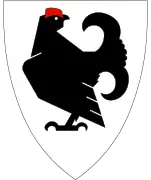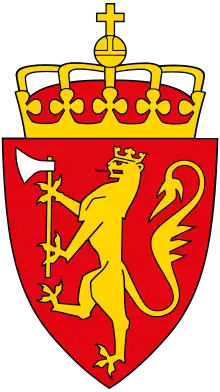Eidskog
Eidskog is a municipality in Innlandet county, Norway. It is located in the traditional district of Vinger. The administrative centre of the municipality is the village of Skotterud. Other villages in the municipality include Magnor, Matrand, and Åbogen.
Eidskog kommune
Eidskogen herred (historic) | |
|---|---|
 View of Magnor | |
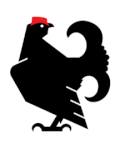 Flag 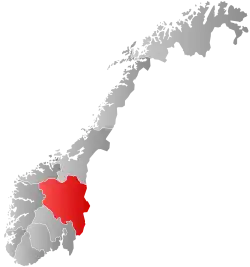 Innlandet within Norway | |
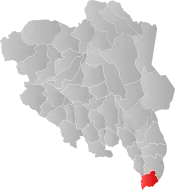 Eidskog within Innlandet | |
| Coordinates: 59°59′53″N 12°3′38″E | |
| Country | Norway |
| County | Innlandet |
| District | Vinger / Glåmdal |
| Established | 1 Jan 1864 |
| • Preceded by | Vinger Municipality |
| Administrative centre | Skotterud |
| Government | |
| • Mayor (2015) | Kamilla Thue (Ap) |
| Area | |
| • Total | 640.40 km2 (247.26 sq mi) |
| • Land | 603.36 km2 (232.96 sq mi) |
| • Water | 37.04 km2 (14.30 sq mi) 5.8% |
| • Rank | #181 in Norway |
| Population (2022) | |
| • Total | 6,032 |
| • Rank | #158 in Norway |
| • Density | 10/km2 (30/sq mi) |
| • Change (10 years) | |
| Demonym | Eidskoging[1] |
| Official language | |
| • Norwegian form | Bokmål |
| Time zone | UTC+01:00 (CET) |
| • Summer (DST) | UTC+02:00 (CEST) |
| ISO 3166 code | NO-3416 |
| Website | Official website |
The 640-square-kilometre (250 sq mi) municipality is the 181st largest by area out of the 356 municipalities in Norway. Eidskog is the 155th most populous municipality in Norway with a population of 6,032. The municipality's population density is 10 inhabitants per square kilometre (26/sq mi) and its population has decreased by 4.1% over the previous 10-year period.[3][4]
General information
The municipality was established on 1 January 1864 when the old Vinger Municipality was divided in two: Vinger (population: 6,226) in the north and Eidskog (population: 6,920) in the south. On 1 January 1986, the northern part of the Åbogen area (population: 14) was transferred from Kongsvinger Municipality to Eidskog Municipality.[5]
Name
The municipality is named Eidskog (Old Norse: Eiðaskógr) since it was an old name for the area. The first element is the plural genitive case of eið which means "isthmus" or in this situation, a "path between two lakes". The first element is skógr which means "woods" or "forest". Thus the name means "the woods with the many eiðs". (In historical times, people traveled in small boats on the lakes and the rivers, but they had to drag the boats over the eids.) Historically, the name was spelled Eidskogen.[6]
Coat of arms
The coat of arms was granted on 12 September 1986. The official blazon is "Argent, a grouse sable regardant crested gules" (Norwegian: I sølv en svart orrhane med hodet vendt bakover). This means the arms have a field (background) has a tincture of argent which means it is commonly colored white, but if it is made out of metal, then silver is used. The charge is a black grouse with a red comb. The design was chosen since this type of bird is a common inhabitant of the many forests in the municipality. Forestry is also one of the main sources of income in the area. The arms were designed by Stein Davidsen. The municipal flag has the same design as the coat of arms.[7][8][9]
Churches
The Church of Norway has two parishes (sokn) within the municipality of Eidskog. It is part of the Solør, Vinger og Odal prosti (deanery) in the Diocese of Hamar.
| Parish (sokn) | Church name | Location of the church | Year built |
|---|---|---|---|
| Eidskog | Eidskog Church | Matrand | 1665 |
| Magnor Church | Magnor | 1923 | |
| Vestmarka | Vestmarka Church | Vestmarka | 1883 |
Geography
The municipality is located in the southeastern part of Innlandet county. It is bordered to the north by the municipality of Kongsvinger (in Innlandet) and in the west by Aurskog-Høland, Nes (both in Viken and Sør-Odal (in Innlandet). Eidskog also borders Sweden, both to the east and south.
The lakes Digeren, Mangen, and Skjervangen are all located in Eidskog.
History
| Ancestry | Number |
|---|---|
| 138 | |
| 33 | |
| 29 | |
| 26 | |
| 24 | |
| 23 | |
| 21 |
The name Eidskog is ancient and was used for the southern part of Vinger, the region between today's Kongsvinger in Norway and Arvika in Sweden. The Vinger Royal Road (Norwegian: Eskoleia) historically traveled through Eidskog (and continues today as the Norwegian National Road 2). It was one of the most important traffic arteries between Norway and Sweden. The name Eidskog was already in use during the saga period and became, after the canonization of Saint Olaf and important pilgrim's route from Europe to Nidaros Cathedral. During the 12th century, the Eidskog Church was built. It was a stave church built in Midtskog (which means Norwegian: middle of the woods). The present Eidskog Church is built on the same site (now called Matrand) and this building was constructed in 1665.
The way through Eidskog was also militarily important and many times through history has been the point of Swedish strikes into Hedmark. To defend against these assaults, a number of fortifications were built in the vicinity, including ones at Magnor and Matrand, but the chief fortification was Kongsvinger Fortress (to the north).
The last Swedish attack through Eidskog was in 1814 when Major General Carl Pontus Gahn on July 31 crossed the border and marched against Kongsvinger. His forces were stopped at Lier outside Kongsvinger on 2 August 1814 by troops led by Lieutenant Colonel Andreas Samuel Krebs (1769-1818) and retreated to Eidskog. On 4 August 1814, Krebs followed after to drive Swedish troops off Norwegian territory. The two forces met in the Battle of Matrand which was the bloodiest battle of the war and ended with a Norwegian victory.
Later in 1814, Norway was joined in union with Sweden and the confrontations at the Eidskog border ended.
The Soot Canal, constructed in 1849, has Norway's oldest sluice gates. It was the work of Engebret Soot (1786–1859). It was built to allow timber to be transported (floated) to the Halden sawmills. The canal was 1.5 kilometres (0.9 mi) long and had 16 locks which extended from Lake Skjervangen at 185 metres (607 ft) above sea level up to Lake Mortsjølungen at 201 metres (659 ft) above sea level.
The route through Eidskog became an important connection between the two countries; this was strengthened with the opening of the Grenseban railway in 1862, which connected Christiania to Stockholm.
Government
All municipalities in Norway are responsible for primary education (through 10th grade), outpatient health services, senior citizen services, welfare and other social services, zoning, economic development, and municipal roads and utilities. The municipality is governed by a municipal council of directly elected representatives. The mayor is indirectly elected by a vote of the municipal council.[11] The municipality falls under the Romerike og Glåmdal District Court and the Eidsivating Court of Appeal.
Municipal council
The municipal council (Kommunestyre) of Eidskog is made up of 25 representatives that are elected to four year terms. The party breakdown of the council is as follows:
| Party Name (in Norwegian) | Number of representatives | |
|---|---|---|
| Labour Party (Arbeiderpartiet) | 9 | |
| Progress Party (Fremskrittspartiet) | 2 | |
| Conservative Party (Høyre) | 3 | |
| Centre Party (Senterpartiet) | 9 | |
| Socialist Left Party (Sosialistisk Venstreparti) | 1 | |
| Liberal Party (Venstre) | 1 | |
| Total number of members: | 25 | |
| Party Name (in Norwegian) | Number of representatives | |
|---|---|---|
| Labour Party (Arbeiderpartiet) | 12 | |
| Progress Party (Fremskrittspartiet) | 2 | |
| Conservative Party (Høyre) | 3 | |
| Centre Party (Senterpartiet) | 7 | |
| Liberal Party (Venstre) | 1 | |
| Total number of members: | 25 | |
| Party Name (in Norwegian) | Number of representatives | |
|---|---|---|
| Labour Party (Arbeiderpartiet) | 10 | |
| Progress Party (Fremskrittspartiet) | 3 | |
| Conservative Party (Høyre) | 5 | |
| Centre Party (Senterpartiet) | 9 | |
| Socialist Left Party (Sosialistisk Venstreparti) | 1 | |
| Liberal Party (Venstre) | 1 | |
| Total number of members: | 29 | |
| Party Name (in Norwegian) | Number of representatives | |
|---|---|---|
| Labour Party (Arbeiderpartiet) | 12 | |
| Progress Party (Fremskrittspartiet) | 6 | |
| Conservative Party (Høyre) | 5 | |
| Centre Party (Senterpartiet) | 4 | |
| Socialist Left Party (Sosialistisk Venstreparti) | 2 | |
| Total number of members: | 29 | |
| Party Name (in Norwegian) | Number of representatives | |
|---|---|---|
| Labour Party (Arbeiderpartiet) | 20 | |
| Progress Party (Fremskrittspartiet) | 2 | |
| Conservative Party (Høyre) | 3 | |
| Centre Party (Senterpartiet) | 2 | |
| Socialist Left Party (Sosialistisk Venstreparti) | 2 | |
| Total number of members: | 29 | |
| Party Name (in Norwegian) | Number of representatives | |
|---|---|---|
| Labour Party (Arbeiderpartiet) | 16 | |
| Progress Party (Fremskrittspartiet) | 3 | |
| Conservative Party (Høyre) | 4 | |
| Centre Party (Senterpartiet) | 4 | |
| Socialist Left Party (Sosialistisk Venstreparti) | 2 | |
| Total number of members: | 29 | |
| Party Name (in Norwegian) | Number of representatives | |
|---|---|---|
| Labour Party (Arbeiderpartiet) | 16 | |
| Conservative Party (Høyre) | 4 | |
| Centre Party (Senterpartiet) | 7 | |
| Socialist Left Party (Sosialistisk Venstreparti) | 2 | |
| Total number of members: | 29 | |
| Party Name (in Norwegian) | Number of representatives | |
|---|---|---|
| Labour Party (Arbeiderpartiet) | 17 | |
| Conservative Party (Høyre) | 3 | |
| Centre Party (Senterpartiet) | 5 | |
| Socialist Left Party (Sosialistisk Venstreparti) | 4 | |
| Total number of members: | 29 | |
| Party Name (in Norwegian) | Number of representatives | |
|---|---|---|
| Labour Party (Arbeiderpartiet) | 20 | |
| Conservative Party (Høyre) | 4 | |
| Christian Democratic Party (Kristelig Folkeparti) | 1 | |
| Centre Party (Senterpartiet) | 2 | |
| Socialist Left Party (Sosialistisk Venstreparti) | 1 | |
| Liberal Party (Venstre) | 1 | |
| Total number of members: | 29 | |
| Party Name (in Norwegian) | Number of representatives | |
|---|---|---|
| Labour Party (Arbeiderpartiet) | 21 | |
| Conservative Party (Høyre) | 3 | |
| Christian Democratic Party (Kristelig Folkeparti) | 1 | |
| Centre Party (Senterpartiet) | 2 | |
| Socialist Left Party (Sosialistisk Venstreparti) | 1 | |
| Liberal Party (Venstre) | 1 | |
| Total number of members: | 29 | |
| Party Name (in Norwegian) | Number of representatives | |
|---|---|---|
| Labour Party (Arbeiderpartiet) | 19 | |
| Conservative Party (Høyre) | 3 | |
| Christian Democratic Party (Kristelig Folkeparti) | 2 | |
| Centre Party (Senterpartiet) | 4 | |
| Socialist Left Party (Sosialistisk Venstreparti) | 1 | |
| Total number of members: | 29 | |
| Party Name (in Norwegian) | Number of representatives | |
|---|---|---|
| Labour Party (Arbeiderpartiet) | 18 | |
| Conservative Party (Høyre) | 2 | |
| Christian Democratic Party (Kristelig Folkeparti) | 2 | |
| Centre Party (Senterpartiet) | 5 | |
| Socialist Left Party (Sosialistisk Venstreparti) | 2 | |
| Total number of members: | 29 | |
| Party Name (in Norwegian) | Number of representatives | |
|---|---|---|
| Labour Party (Arbeiderpartiet) | 20 | |
| Conservative Party (Høyre) | 2 | |
| Centre Party (Senterpartiet) | 5 | |
| Socialist People's Party (Sosialistisk Folkeparti) | 1 | |
| Liberal Party (Venstre) | 1 | |
| Total number of members: | 29 | |
| Party Name (in Norwegian) | Number of representatives | |
|---|---|---|
| Labour Party (Arbeiderpartiet) | 22 | |
| Conservative Party (Høyre) | 1 | |
| Centre Party (Senterpartiet) | 4 | |
| Socialist People's Party (Sosialistisk Folkeparti) | 1 | |
| Liberal Party (Venstre) | 1 | |
| Total number of members: | 29 | |
| Party Name (in Norwegian) | Number of representatives | |
|---|---|---|
| Labour Party (Arbeiderpartiet) | 21 | |
| Conservative Party (Høyre) | 1 | |
| Communist Party (Kommunistiske Parti) | 1 | |
| Centre Party (Senterpartiet) | 3 | |
| Socialist People's Party (Sosialistisk Folkeparti) | 1 | |
| Liberal Party (Venstre) | 2 | |
| Total number of members: | 29 | |
| Party Name (in Norwegian) | Number of representatives | |
|---|---|---|
| Labour Party (Arbeiderpartiet) | 19 | |
| Conservative Party (Høyre) | 2 | |
| Communist Party (Kommunistiske Parti) | 2 | |
| Centre Party (Senterpartiet) | 4 | |
| Liberal Party (Venstre) | 2 | |
| Total number of members: | 29 | |
| Party Name (in Norwegian) | Number of representatives | |
|---|---|---|
| Labour Party (Arbeiderpartiet) | 19 | |
| Communist Party (Kommunistiske Parti) | 3 | |
| Farmers' Party (Bondepartiet) | 4 | |
| Joint List(s) of Non-Socialist Parties (Borgerlige Felleslister) | 3 | |
| Total number of members: | 29 | |
| Party Name (in Norwegian) | Number of representatives | |
|---|---|---|
| Labour Party (Arbeiderpartiet) | 17 | |
| Communist Party (Kommunistiske Parti) | 4 | |
| Farmers' Party (Bondepartiet) | 3 | |
| Joint List(s) of Non-Socialist Parties (Borgerlige Felleslister) | 4 | |
| Total number of members: | 28 | |
| Party Name (in Norwegian) | Number of representatives | |
|---|---|---|
| Labour Party (Arbeiderpartiet) | 16 | |
| Communist Party (Kommunistiske Parti) | 6 | |
| Farmers' Party (Bondepartiet) | 2 | |
| Joint List(s) of Non-Socialist Parties (Borgerlige Felleslister) | 4 | |
| Total number of members: | 28 | |
| Party Name (in Norwegian) | Number of representatives | |
|---|---|---|
| Labour Party (Arbeiderpartiet) | 15 | |
| Communist Party (Kommunistiske Parti) | 7 | |
| Christian Democratic Party (Kristelig Folkeparti) | 2 | |
| Joint List(s) of Non-Socialist Parties (Borgerlige Felleslister) | 4 | |
| Total number of members: | 28 | |
| Party Name (in Norwegian) | Number of representatives | |
|---|---|---|
| Labour Party (Arbeiderpartiet) | 19 | |
| Conservative Party (Høyre) | 2 | |
| Farmers' Party (Bondepartiet) | 2 | |
| Liberal Party (Venstre) | 3 | |
| Joint List(s) of Non-Socialist Parties (Borgerlige Felleslister) | 2 | |
| Total number of members: | 28 | |
| Note: Due to the German occupation of Norway during World War II, no elections were held for new municipal councils until after the war ended in 1945. | ||
Mayors
The mayors of Eidskog:
- 1864-1872: Henry T. Fearnley
- 1872-1879: Haagen Pedersen Malmer
- 1879-1895: Meldal Johnsen
- 1895-1897: O. Løken
- 1897-1905: Hans Taugbøl
- 1905-1907: O. Løken
- 1908-1913: Otto Pramm[31]
- 1913-1915: Ole Syversen Fagernæs (V)
- 1915-1915: M. T. Huse
- 1915-1916: Olof Nilsson[32]
- 1917-1919: Otto Pramm
- 1920-1922: H. A. Rambøl
- 1923-1928: Thorvald Taugbøl
- 1929-1934: Kaspar Billerud
- 1935-1945: Selmer Alm (Ap)
- 1945-1947: Hallgrim Sørli (Ap)
- 1948-1963: Sigurd Skjørberg
- 1964-1981: Ivar Delviken
- 1982-1983: Kaare Fjeld
- 1984-1999: Kåre Delviken
- 1999-2005: Ivar Skulstad (Ap)
- 2005-2007: Greta Storm Ofteland (Ap)
- 2007-2015: Knut Gustav Woie (Sp)
- 2015–present: Kamilla Thue (Ap)
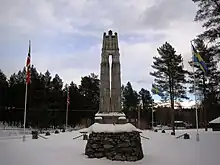
Attractions
- Soot Canal - the first lock constructed in Norway, used for log floating
- Grenselosmuseet - museum on the route for escape to Sweden during the World War II
- Oppistun Børli - poet Hans Børli's home
- Morokulien - memorial to the long lasting peace with Sweden
- Rønning Treski - last wood ski producer in Norway
Notable people
.jpg.webp)
- Erik Werenskiold (1855 in Eidskog – 1938), a Norwegian painter and illustrator
- Konrad Hirsch (1900 in Eidskog – 1924), a Swedish footballer, played in 1924 Summer Olympics
- Julla Sæthern (1901 in Eidskog – 1981), a Norwegian barrister, feminist and politician
- Hans Børli (1918 at Eidskog – 1989), a Norwegian poet, writer and lumberjack
- Torgrim Sollid (born 1942 in Eidskog), a composer and folk and jazz musician
- Ivar Skulstad (born 1953), a politician and Mayor of Eidskog 1999 to 2005
- Kristin Solli Schøien (born 1954), an author and composer, lives in Eidskog
- Max Ivan Lindkjølen (born 1956), a chef and entrepreneur [33]
- Remi Eriksen (born 1967), the Group President and CEO of DNV GL, a classification society
- Wilhelm Brenna (born 1979), a retired Norwegian ski jumper, junior world champion
- Andreas Ulvo (born 1983), a jazz pianist, organist, keyboardist and composer
References
- "Navn på steder og personer: Innbyggjarnamn" (in Norwegian). Språkrådet.
- "Forskrift om målvedtak i kommunar og fylkeskommunar" (in Norwegian). Lovdata.no.
- Statistisk sentralbyrå. "Table: 06913: Population 1 January and population changes during the calendar year (M)" (in Norwegian).
- Statistisk sentralbyrå. "09280: Area of land and fresh water (km²) (M)" (in Norwegian).
- Jukvam, Dag (1999). "Historisk oversikt over endringer i kommune- og fylkesinndelingen" (PDF) (in Norwegian). Statistisk sentralbyrå. ISBN 9788253746845.
- Rygh, Oluf (1900). Norske gaardnavne: Hedmarkens amt (in Norwegian) (3 ed.). Kristiania, Norge: W. C. Fabritius & sønners bogtrikkeri. p. 218.
- "Civic heraldry of Norway - Norske Kommunevåpen". Heraldry of the World. Retrieved 23 April 2023.
- "Eidskog, Hedmark (Norway)". Flags of the World. Retrieved 23 April 2023.
- "Godkjenning av våpen og flagg". Lovdata.no (in Norwegian). Norges kommunal- og arbeidsdepartementet. 12 September 1986. Retrieved 23 April 2023.
- "Immigrants and Norwegian-born to immigrant parents, by immigration category, country background and percentages of the population". ssb.no. Archived from the original on 2 July 2015. Retrieved 29 June 2015.
- Hansen, Tore; Vabo, Signy Irene, eds. (20 September 2022). "kommunestyre". Store norske leksikon (in Norwegian). Kunnskapsforlaget. Retrieved 14 October 2022.
- "Tall for Norge: Kommunestyrevalg 2019 - Innlandet". Valg Direktoratet. Retrieved 20 March 2022.
- "Tall for Norge: Kommunestyrevalg 2015 - Hedmark". Valg Direktoratet.
- "Table: 04813: Members of the local councils, by party/electoral list at the Municipal Council election (M)" (in Norwegian). Statistics Norway.
- "Tall for Norge: Kommunestyrevalg 2011 - Hedmark". Valg Direktoratet.
- "Kommunestyrevalget 1995" (PDF) (in Norwegian). Oslo-Kongsvinger: Statistisk sentralbyrå. 1996.
- "Kommunestyrevalget 1991" (PDF) (in Norwegian). Oslo-Kongsvinger: Statistisk sentralbyrå. 1993.
- "Kommunestyrevalget 1987" (PDF) (in Norwegian). Oslo-Kongsvinger: Statistisk sentralbyrå. 1988.
- "Kommunestyrevalget 1983" (PDF) (in Norwegian). Oslo-Kongsvinger: Statistisk sentralbyrå. 1984.
- "Kommunestyrevalget 1979" (PDF) (in Norwegian). Oslo: Statistisk sentralbyrå. 1979.
- "Kommunevalgene 1975" (PDF) (in Norwegian). Oslo: Statistisk sentralbyrå. 1977.
- "Kommunevalgene 1972" (PDF) (in Norwegian). Oslo: Statistisk sentralbyrå. 1973.
- "Kommunevalgene 1967" (PDF) (in Norwegian). Oslo: Statistisk sentralbyrå. 1967.
- "Kommunevalgene 1963" (PDF) (in Norwegian). Oslo: Statistisk sentralbyrå. 1964.
- "Kommunevalgene og Ordførervalgene 1959" (PDF) (in Norwegian). Oslo: Statistisk sentralbyrå. 1960.
- "Kommunevalgene og Ordførervalgene 1955" (PDF) (in Norwegian). Oslo: Statistisk sentralbyrå. 1957.
- "Kommunevalgene og Ordførervalgene 1951" (PDF) (in Norwegian). Oslo: Statistisk sentralbyrå. 1952.
- "Kommunevalgene og Ordførervalgene 1947" (PDF) (in Norwegian). Oslo: Statistisk sentralbyrå. 1948.
- "Kommunevalgene og Ordførervalgene 1945" (PDF) (in Norwegian). Oslo: Statistisk sentralbyrå. 1947.
- "Kommunevalgene og Ordførervalgene 1937" (PDF) (in Norwegian). Oslo: Statistisk sentralbyrå. 1938.
- "Eidskog herredsstyre". Hedemarkens Amtstidende. 8 July 1910. Retrieved 16 December 2015.
- "Eidskogen herredsstyre". Hedemarkens Amtstidende. 14 December 1915. Retrieved 16 December 2015.
- "Om Oss". MaxIvan (in Norwegian Bokmål). 22 June 2012. Retrieved 15 June 2019.
External links
 Media related to Eidskog at Wikimedia Commons
Media related to Eidskog at Wikimedia Commons The dictionary definition of Eidskog at Wiktionary
The dictionary definition of Eidskog at Wiktionary- Municipal fact sheet from Statistics Norway (in Norwegian)
- Culture in Eidskog on the map (in Norwegian)
